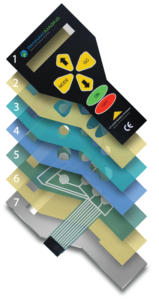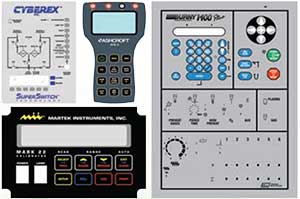Membrane Switch Products
What is a “Membrane Switch”?
A membrane switch is a printed electronic circuit that uses pressure to open and close a circuit. The membrane switch circuitry is most often screen printed using conductive inks, which are typically made of silver, carbon, and/or graphite.
Membrane switches are part of a range of devices considered to be user interfaces (also called operator interfaces, or man-machine interfaces) along with display-based touch screens, and mechanical switches such as push-button, toggle, rocker, and slide switches. The ultimate purpose of a membrane switch is to serve as the interface between man and machine, enabling an operator to communicate with a piece of equipment, instrument, or machinery.
Features & benefits of membrane switches include:
- Completely sealed surface – easily cleaned and sterilized
- Low Profile – no crevices that can trap contaminants
- A cost-effective alternative – less costly than rubber keypad assemblies and capacitive touch keypads
- Thin profile – saves valuable space in your product design
- Easy to interface with existing controllers – no special electronics required, as with touch screens
- Versatile graphic interface – overlays can be screen or digitally printed with stunning, photo-quality graphic effects
- Protection by design – Easier to protect from UV radiation than rubber keypads
- Water-resistant designs – meets NEMA 4 and IP 67 specifications
How Are Membrane Switches Constructed?
Membrane switches are essentially a sandwich of thin layers that are bonded together using pressure sensitive adhesives. Depending on the application requirements, a membrane switch will consist of as few as 4, and as many as 9 layers. In contrast to mechanical switches, membrane switches offer the advantage of lower cost, they consume less design space with their low profile, are easy to clean, and they offer a sleeker, ergonomic, and aesthetically pleasing appearance.
The visible top layer of a membrane switch is the graphic overlay, with printed circuitry underneath the overlay. The circuitry can also incorporate different layers such as polyester (silver flex), polyimide (copper flex), and rigid PCB layers. Activation of a switch occurs when a printed shorting pad or metal dome makes contact with the bottom circuit layer thus, closing the circuit.
Pannam Membrane Switch Technical Information
Graphic Overlay – Polyester is usually the material of choice due to its superior chemical resistance and flex life compared to polycarbonate. Pannam can either digitally print, screen-print, or employ a combination of both methods to ensure you get the right colors, textures and finishes your design requires.
- Overlay Adhesive – This adhesive layer bonds the graphic overlay to the top circuit layer, and is typically an acrylic adhesive.
- Top Circuit Layer – This is a 0.005″ – 0.007″ heat stabilized polyester printed with silver-filled electrically conductive inks and also dielectric inks.
- Circuit Spacer – This layer separates the top circuit from the bottom circuit so the switch remains normally open until the keypad is pressed. The circuit spacer is a polyester spacer with adhesive on both sides.
- Lower Circuit Layer – This is a 0.005″ – 0.007″ heat stabilized polyester printed with silver-filled electrically conductive inks and also dielectric inks. This layer terminates as a flexible tail that serves as the interconnect to controller PCBs or other electronics.
- Rigid Support Layer – This optional layer can add structural integrity to the membrane switch assembly.
What Special Features Can Be Incorporated into Membrane Switches?
Tactile Feedback
Membrane switches can be manufactured with non-tactile switches, which activate with 4 – 8 oz of touch pressure. Non-tactile switches are less expensive and provide the longest switch life. Tactile switches have a snap-action feel and may also be incorporated into a membrane switch, enhancing tactile feedback, but with a greater cost and lower switch life.
Lighting Options
There are three standard methods for illuminating membrane switches.
Light Emitting Diodes (LEDs) are a popular, low-cost, point-source lighting method to back light membrane switches. LED’s emit very little heat, and come in a variety of colors, lamp packages, and intensity levels. LED’s are used as indicator lights and are not designed for overall back lighting of a panel.
A second option is optical fibers. Fiber optic lamps are an effective method to achieve more uniform back lighting across a broader area of the membrane switch keypad. With fiber optic back lighting, light from a light source, normally an LED, is evenly distributed under the graphics by use of very thin plastic fibers. Optical fibers are not affected by extremes in humidity (0% to 100%) or temperature (-40 to +85 deg C).
The third option is electroluminescent (EL) lamps. They are lower priced compared to optical fibers and offer additional design flexibility. EL lamps are best suited for applications where the back light is a minimum requirement, because the phosphors tend to decay with extended use at high voltages and frequencies. Thus EL lamps are not a good choice if the lamp is on for an extended period of time.
Most Common Design Features Include:
- Graphic overlays digitally and/or screen printed to resemble a wide range of surfaces including glass, metal, wood, and stone
- Transparent and tinted display windows
- Selective textures and UV hard-coat surface finishes
- Tactile and non-tactile feedback with metal or polyester domes
- Pillow or rim-embossed graphic overlays
- Embedded LEDs
- Fiber Optic backlighting
- EL (Electroluminescent) backlighting
- Rigid support backers such as aluminum and FR4 with PEM mounting fasteners
- EMI/RFI shielding
- Standard connectors on .100″ centers, or prepared for zif connections
What Industries Use Membrane Switches?
Membrane switches can be found in a variety of different industries. Medical instrumentation and laboratory equipment are ideal markets for membrane switches. These switches can be designed to be sealed from moisture and contaminants and with anti-microbial coatings to resist bacterial growth and harsh chemicals. Membrane switches are also utilized in industries such as electronic test and telecommunication networking equipment. Industrial controls and fitness equipment are also industries where membrane switches are the user interface of choice.
 Graphic Overlay – Polyester is usually the material of choice due to its superior chemical resistance and flex life compared to polycarbonate. Pannam can either digitally print, screen-print, or employ a combination of both methods to ensure you get the right colors, textures and finishes your design requires.
Graphic Overlay – Polyester is usually the material of choice due to its superior chemical resistance and flex life compared to polycarbonate. Pannam can either digitally print, screen-print, or employ a combination of both methods to ensure you get the right colors, textures and finishes your design requires.